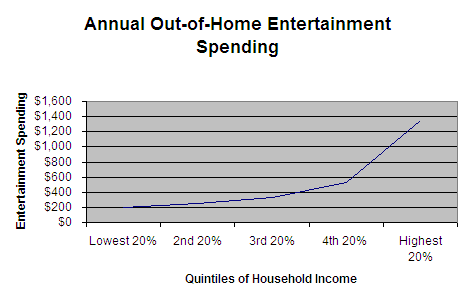
Vol. II, No. 5, August 2002
AMERICANS SPENDING BEYOND THEIR MEANS
Information from the Bureau of Labor Statistics shows that Americans with the lowest 60% of incomes continue to live beyond their means by using credit card debt and by tapping their home equity. In 2000, households with the 2nd lowest 20% (quintile) of income on average earned $18,600 but spent $26,500, $7,900 more than they earned. The 3rd lowest 20% of households by income had average incomes of $31,300 and overspent that income by $3,300. Only the top of 40% of households by income spent less than they earned.
Right now, with low interest rates, the burden of home equity and credit card debt remains manageable for many of these lower income families. However, that is not likely to continue. When interest rates climb, many of these households will no longer be able to maintain their spending. When that happens, discretionary expenditures like out-of-home entertainment are likely to be cut back or eliminated.
Household spending for out-of-home entertainment is basically proportional to household income. Information from the Bureau of Labor Statistics' Consumer Expenditure Survey shows that households with the 4th highest 20% of incomes spend 175% as much as the 3rd highest 20% spend, and the highest 20% of income households spend twice the amount as the 4th highest 20%, and almost 4 times as much as the 3rd highest 20% of incomes.
This is a very important characteristic to evaluate in a market study. At White Hutchinson, when we do market studies, we not only look at total market area population, but more importantly, we look at a detailed socio-economic breakdown of households and families. A market area with a lower population but larger proportion of higher income families can easily generate more revenues for a project than a larger market population with a lower proportion of higher income families. The higher income areas will also be less vulnerable to a recession. We take this pattern of spending by socio-economic segments into consideration when we develop pro forma financial projections for projects.



